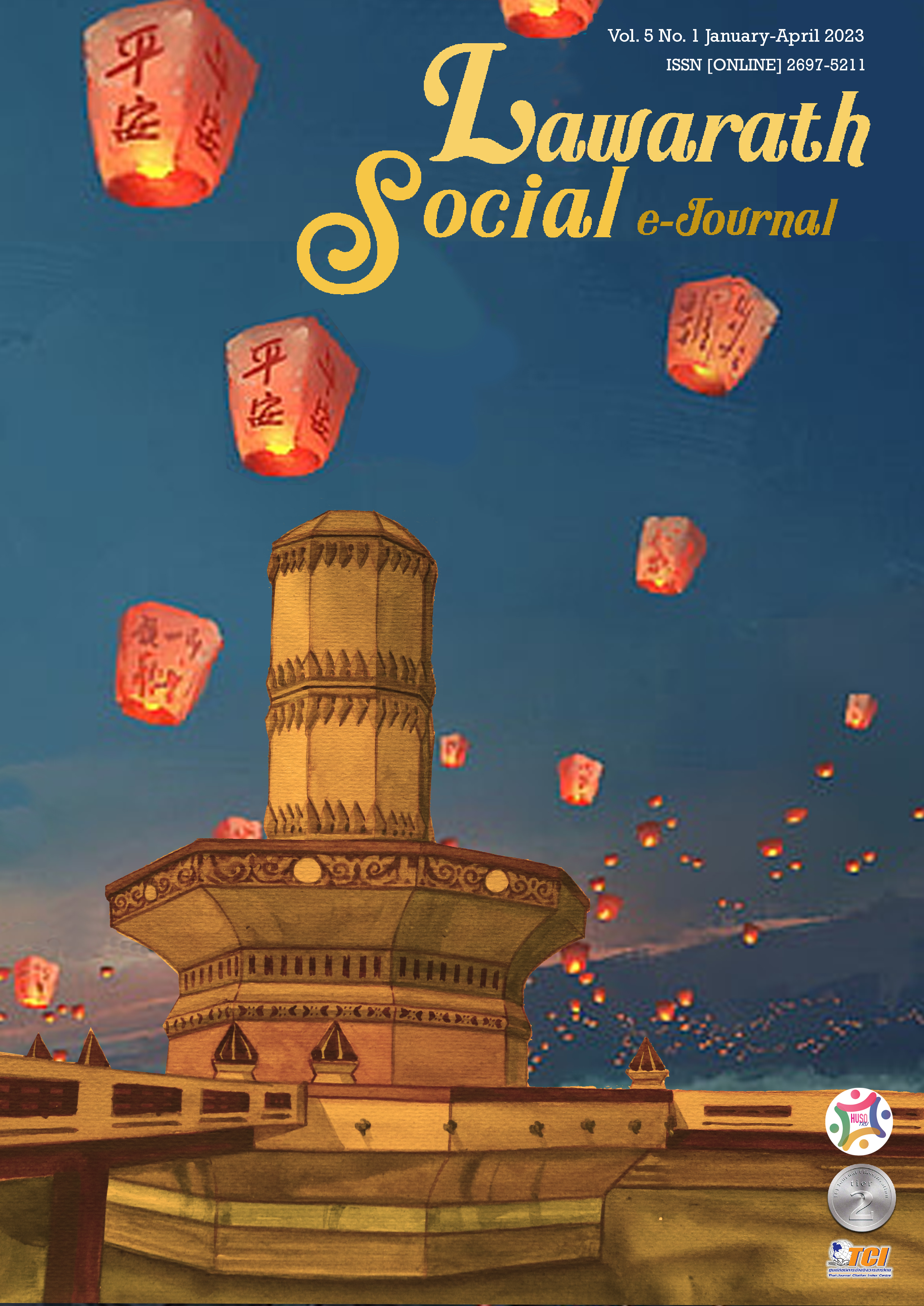The Study of Roots of Life Symbolism in the Chinese Novel “Red Sorghum”
Keywords:
Red Sorghum, Muo Yan, Roots of Life, Symbols in the Novel, Tamnan Rak Thung Si PhloengAbstract
This article aimed to study the symbols representing the roots of life that appear in the Chinese novel "Red Sorghum" (红高粱家族) by Muo Yan (莫言). The study methodology is to collect data from the novel text; after that, take data for analysis, and write the results in descriptive analysis. The study has found symbols that represent the roots of life appearing in the story consisting of 2 categories. First category is natural and geographical symbols, including 1. The red sorghum and 2. The black soil and The Black River. The second category is the sociological and cultural symbols, including 1. The red sorghum liquor, 2. The spring pancake, and 3. The grandmother. Each of these symbols conveys its own symbolic and cultural meaning that expresses the root of life, with a relationship that cannot be separated. At the same time, these symbols represent the roots of life, one of which has a common meaning that needs to be communicated is to survive. The roots of life reflect the basis of the existence of life and the struggle for the survival of human life. These symbols convey more than the words they appear. The roots of life appear in symbolic forms in this Chinese novel to convey the meaning of culture, the way of life. This is a part of a cultural system that readers and researchers are involved in determining the implications of the symbols appearing in the literature.
Downloads
References
กาญจนา แก้วเทพ. (2552). การวิเคราะห์สื่อ: แนวคิดและเทคนิค. กรุงเทพฯ: ภาพพิมพ์.
กุหลาบ มัลลิกะมาส. (2538). วรรณคดีวิจารณ์ (พิมพ์ครั้งที่ 9). กรุงเทพฯ: มหาวิทยาลัยรามคำแหง.
ชยุตม์ อินต๊ะยะ. (2557). การผลิตเอทานอลจากเมล็ดข้าวฟ่างโดยการเพาะเลี้ยงร่วมระหว่างจุลินทรีย์ที่ผลิตเอนไซม์อะไมโลไลติกและเอทานอล. วิทยานิพนธ์ปริญญามหาบัณฑิต จุฬาลงกรณ์มหาวิทยาลัย.
ไชยรัตน์ เจริญสินโอฬาร. (2555). สัญวิทยา โครงสร้างนิยม หลังโครงสร้างนิยมกับการศึกษารัฐศาสตร์ (พิมพ์ครั้งที่ 2). กรุงเทพฯ: วิภาษา.
ณรงค์ศักดิ์ เสนาณรงค์. (2533). เรื่องที่ 7 ข้าวฟ่างและการใช้ประโยชน์จากข้าวฟ่าง. สารานุกรมไทยสำหรับเยาวชน ฉบับเฉลิมพระเกียรติฯ เล่มที่ 14. กรุงเทพฯ: โครงการสารานุกรมไทยสำหรับเยาวชน โดยพระราชประสงค์ในพระบาทสมเด็จพระเจ้าอยู่หัว.
ดวงมน จิตร์จำนง. (2527). สุนทรียภาพในภาษาไทย. กรุงเทพฯ: เคล็ดไทย.
เถกิง พัฒโนภาษ. (2551, มกราคม-ธันวาคม). สัญศาสตร์กับภาพแทนความ. วารสารวิชาการคณะสถาปัตยกรรมศาสตร์ จุฬาลงกรณ์มหาวิทยาลัย, 57(1), 35-50.
นัยน์พัศ อธิษฐ์พัส. (2561). ความย้อนแย้งแห่งเสรีภาพในนวนิยายเรื่อง ความฝันในหอแดงและนวนิยายของมั่วเหยียน. วิทยานิพนธ์ปริญญาดุษฎีบัณฑิต จุฬาลงกรณ์มหาวิทยาลัย.
นพพร ประชากุล. (2552). ยอกอักษร ย้อนความคิด. กรุงเทพฯ: เคล็ดไทย.
บุญยงค์ เกศเทศ. (2536). แลลอดวรรณกรรมไทย. กรุงเทพฯ: โอเดียนสโตร์.
บุญเหลือ เทพยสุวรรณ, หม่อมหลวง. (2522). วิเคราะห์รสวรรณคดีไทย (พิมพ์ครั้งที่ 2). กรุงเทพฯ: ไทยวัฒนาพานิช.
ประคอง นิมมานเหมินท์ ,และศิริพร ณ ถลาง. (2551). นิทานพื้นบ้านศึกษา. กรุงเทพฯ: โครงการตำราคณะอักษรศาสตร์ จุฬาลงกรณ์มหาวิทยาลัย.
ประเทืองพร วิรัชโภคี, ผู้แปล. (2557). ตำนานรักทุ่งสีเพลิง. กรุงเทพฯ: เอโนเวล.
ราชบัณฑิตยสถาน. (2556). พจนานุกรมฉบับราชบัณฑิตยสถาน พ.ศ. 2554. กรุงเทพฯ: นานมีบุ๊คส์พับลิเคชั่นส์.
สายวรุณ สุนทโรทก. (2559). มายาคติและรหัสวัฒนธรรมใน “ไส้เดือนตาบอดในเขาวงกต”. เอกสาร เสนอต่องานประชุมเสนอบทความทางวิชาการด้านไทยศึกษา มหาวิทยาลัยรามคำแหง วันที่ 26 - 28 ตุลาคม 2559. กรุงเทพฯ: มหาวิทยาลัยรามคำแหง.
อมรา เทศกรณ์. (2520). การวิเคราะห์คุณค่าหนังสือนอกเวลาระดับมัธยมศึกษาตอนปลาย.วิทยานิพนธ์ปริญญามหาบัณฑิต จุฬาลงกรณ์มหาวิทยาลัย.
Potts, A. (1996). Sign in Robert S. Nelson and Richard Shiff: Critical Terms for Art History. Chicago: University of Chicago Press.
Barthes, R. (2544). มายาคติ/สรรนิพนธ์=Mythologies. วรรณพิมล อังคศิริสรรพ, ผู้แปล. กรุงเทพฯ: คบไฟ.
He, W. (2020, December). A Brief Discussion on the Narrative Charm of "Red Sorghum". Yalujiang Literary Monthly Journal, 2020(12), 60.
Li, R. (2021, July). Interpretation of the Phenomenological Attitude of "Returning to
the Thing itself" in Root-seeking Literature-Based on Han Shaogong "Papa" as an example". Peony Periodical Journal Evaluation Column, 2021, 38-40.
Li, W.. (2018). Animal Imagery in Mo Yan's Novels. Master's thesis, Kashgar University.
Lin, X., &Xiao, J. (2011). "The Vault of Novellas". Guangzhou: Huacheng.
Liu, X. (2020, February). Appreciation and Analysis of Female Images in Mo Yan's Novels. Journal of Suzhou Institute of Education, 23(1), 58-60.
Mo, Y. (2003). Red Sorghum Clan. Beijing: Contemporary World Publishing House.
Qiannongwang. (2017). Efficacy and Function of Sorghum Rice. Retrieved August 31, 2021, from ttp://www.qnong.com.cn/jiankang/yingyang/17045.html.
Wang, X. (2015). Modern and Contemporary Chinese Literature. Beijing: Beijing University Press.
Wen, D. (2007). Interpretation of the Red Archetype in the Red Sorghum Clan. Master’s thesis, Hunan Science and Technology University.
Downloads
Published
How to Cite
Issue
Section
License

This work is licensed under a Creative Commons Attribution-NonCommercial-NoDerivatives 4.0 International License.



